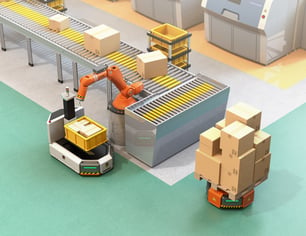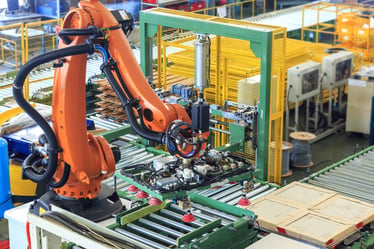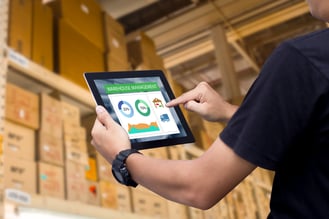 Warehouse storage and retrieval are set to undergo a worldwide change over the next decade. Automated warehouses will delegate many of the tasks now performed by people to robots, including automated guided vehicles (AGVs). Warehouses with automated storage and retrieval systems (ASRS) will have several advantages over those that rely on human labour.
Warehouse storage and retrieval are set to undergo a worldwide change over the next decade. Automated warehouses will delegate many of the tasks now performed by people to robots, including automated guided vehicles (AGVs). Warehouses with automated storage and retrieval systems (ASRS) will have several advantages over those that rely on human labour.
This new network of automation is going to be more advanced than the partially automated warehouse systems in use today. Labour is one of the greatest expenses in warehouse operations and, once the refitting costs have been recouped, an automated warehouse will greatly increase profits for a company.
Robot-Driven Retail
Automated warehouses are the future of retail sales, especially for fast-moving consumer goods (FMCG). The adoption of automated storage, retrieval, sorting and shipping is an investment that will pay dividends in the form of reduced labour costs and higher efficiency and speed. Industry disruptor Amazon has begun implementation of warehouse automation with up to 45,000 robots currently in operation at its warehouses.

Industry 4.0 is Coming
The e-commerce model is here to stay, and consumers are getting used to the nearly instant gratification that comes from buying online and receiving goods within a day or two. Disruptors eventually set industry standards, and those who don't keep up with automated warehouse innovations will be at a disadvantage in the future.
Labour Shortages
In the United Kingdom, automation could be the antidote to labour shortages caused by Brexit. Not only can a company use robotic systems to choose, sort, package, and mail goods, but breakthroughs in limited artificial intelligence (AI) have created the capability for customer service applications. Imagine using a computerised system that, in addition to rapidly shipping the product, can deal with customer inquiries and fulfil requests.
ASRS Preparation and Integration
An automated supply chain is well suited to FMCG processing throughout the sales cycle, from ordering to shipping. However, automation will require a complete and detailed analysis of the supply chain and scrutiny of customer demand and change order trends.
Every step of storage and retrieval, from start to finish, will have to be dissected, analysed and reconfigured to ensure the smooth operation of an ASRS. The success of warehouse automation will rely on the optimal interaction of robotics, smart data and integrated systems.
Robotics
Robots are smaller and more affordable now, allowing more companies to use them. This not only reduces warehouse costs but also increases available floor space. And the use of 3-D printing is now well beyond the prototype stage, allowing robotic replacement parts to be manufactured on site.
 Smart Data
Smart Data
Computers have always had the ability to do lightning-fast calculations and access data almost instantaneously. Now, they can be linked in a network that allows complex data analyses and adjustments to take place as needed. Output and delivery quotas can be automatically changed according to inventory, weather and other factors programmed into the network.
Integrated Systems
The Internet of Things is also upon us. Many electronics now have the capability to communicate with the Web, and robots are no exception. Performance metrics, maintenance needs and other data can be updated in real time. Access to the cloud makes data storage and retrieval easier and faster, and it can even allow access to technical data needed to perform the job.
Automated Warehouse Case Study
 Online grocery store Ocado has already implemented much of the technology that's going to be routine in the next few years. Their facility near Andover is a snapshot of how warehouses will look in the future. The space is laid out in a grid that resembles a giant hive, one that's populated by over a thousand washing-machine-sized AGVs in continual motion.
Online grocery store Ocado has already implemented much of the technology that's going to be routine in the next few years. Their facility near Andover is a snapshot of how warehouses will look in the future. The space is laid out in a grid that resembles a giant hive, one that's populated by over a thousand washing-machine-sized AGVs in continual motion.
Crates are stacked according to an algorithm that determines the likelihood that they'll need to be moved again soon. At the start and finish of the assembly line, people unload and repackage the groceries, with the AGV robots responsible for storage and retrieval in-between.
The central computer coordinates the robots, allowing them to use teamwork to quickly unpack a stack of crates to get to the one that's needed. At this stage, robots do a great job of moving crates around and picking hard-surfaced items from them. They still have problems with irregularly shaped or delicate items, but better technology for these types of tasks is coming soon.
Objections to Automation
Initial Investment.jpg?width=297&name=shutterstock_572649643%20(1).jpg)
There will be an initial labour cost increase during preparations to bring systems online for automated picking and packaging. Computer mapping, simulations and trial operations are some of the areas that will involve capital outlays. Once Industry 4.0 is underway, though, the opportunities for earnings will increase exponentially.
Resistance to Change
There's resistance to automation because of the challenges involved in the transition to the automated warehouse model. Machines work within a prescribed set of parameters, and conditions must be optimal for them to perform properly. Warehouse renovations will be necessary to ensure the smooth functioning of the new robotic systems.
Automation Benefits
- Competitive advantage
- Profitability
- Faster shipping
- Worker safety
- Precision
- Efficiency
- Round-the-clock operations
Automation Challenges
- Capital outlay
- Facility renovation
- Unexpected modifications
- Narrow operational parameters
- Testing and trials
How to Prepare
Martin Thomas, European Marketing Manager at Radwell International Ltd explains more. “Humans possess the ability to identify problems, devise strategies to deal with them, and adapt operations to accommodate change. One of the major thrusts of Industry 4.0 theory is promoting awareness that machines are fast approaching the same proficiency. Warehouse automation systems are modular, and businesses can automate operations in stages. The complete transition doesn't have to take place overnight, but it's vital to realise that automation will have to occur for a company to continue to compete successfully in the future.”
Radwell International Ltd is a global leader in MRO and industrial automation solutions, recognised as the world’s largest stockist, with an inventory of over 20 million industrial automation parts.









